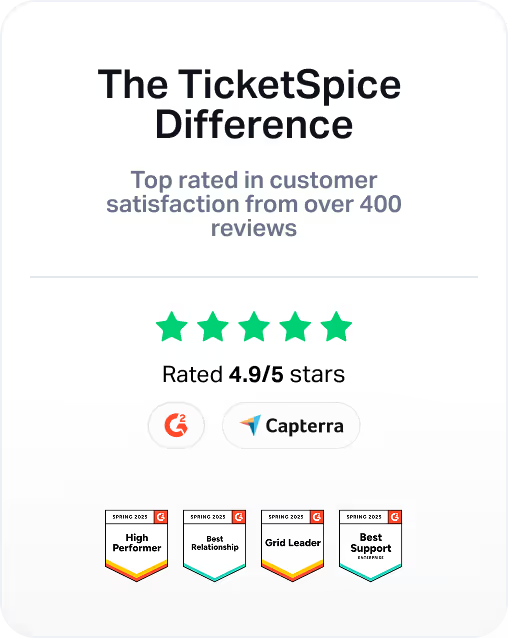Why Seating Choices Matter More Than You Think
The right seating strategy can shape everything from ticket sales and guest satisfaction to how your event is remembered. Think of it as setting the stage (literally) for your guests’ entire experience.
Whether you’re running a high-energy music festival or a polished farm-to-table banquet, the wrong seating model can make or break your big day. Let’s make sure you pick the one that fits.
What Is General Admission?
General Admission (GA) tickets grant attendees entry into a generalized area of the event. Everyone in the general admission category holds the same type of ticket, and the seating or standing areas are available on a first-come, first-served basis. It’s simple and flexible.
The Upsides of General Admission
➕ Easy to set up – No need to manage seat maps or assignments with GA. Just open the doors and let the crowd flow.
➕Perfect for high-energy events – Concerts, festivals, and parades can thrive on the buzz of people choosing their own spots.
➕Creates urgency – When people know the best seats go fast, they’ll be encouraged to buy and show up on time.
The Downsides of General Admission
➖ Long lines – When attendees have to show up early to claim spots, it can create crowd management challenges.
➖ Guest frustration – If groups can’t sit together, or guests feel anxious about limited space, guest frustrations may run high.
➖ Limited pricing flexibility – If GA is your only offering, it’s harder to charge premium prices without specific sections or seats.
Reserved Seating Unpacked (A Different Experience Entirely)
With a reserved seating model, every guest chooses their exact spot when purchasing. There’s less flexibility but also less ambiguity. Here are some of the pros and cons.
Why Reserved Seating Works So Well
➕ More comfort and predictability – Guests know exactly where they’ll sit before they arrive.
➕ Premium pricing opportunities – You can charge more for front-row or VIP sections.
➕ Smoother check-in and flow – There’s no mad rush to save seats, and often and fewer onsite headaches.
The Trade-Offs of Reserved Seating
➖ More setup time – You’ll need to create and manage a seating chart.
➖ Less suited for casual events – Not ideal for general admission-style crowds or flexible spaces.
➖ Higher costs – Some software will charge you more for the setup and mapping tools. With TicketSpice, however, the setup is free.
The Real Differences Between Reserved and GA
General Admission
💵 Ticket Pricing: Usually flat-rate with fewer upsell opportunities.
💯 Attendee Experience: Energetic, spontaneous, and ideal for high-energy crowds.
🧩 Setup Effort: Minimal with no seat map or complex configuration needed.
🚀 Scalability: Easy to expand for open spaces or large, flexible venues.
Reserved Seating
💵 Ticket Pricing: Enables tiered pricing and VIP upgrades for higher revenue.
💯 Attendee Experience: Predictable and comfortable. Guests know exactly where they’ll be.
🧩 Setup Effort: Requires seat mapping and more planning.
🚀 Scalability: Less scalable if the venue capacity is already set.
Matching the Model to Your Venue Type
Your event venue should play a significant role in determining the model you choose for your event. Smaller venues, clubs, and local festivals are usually a good fit for general admission. Additionally, if your attendees want the freedom to move, dance, and mingle, GA might be a better fit for the vibe. On the other hand, theaters, arenas, and high-production concerts benefit from reserved seating. It gives structure to large crowds and ensures everyone receives the experience they paid for.
How Your Audience Shapes the Right Choice
Your audience’s personality also says a lot about what kind of setup will work. Younger, energetic crowds often love the freedom and excitement of GA. If someone wants to switch seats in the middle of the event, they can. In contrast, families or older guests usually appreciate the certainty of reserved seating, where they can plan ahead and avoid the chaos of fighting for seats. The more you understand your attendees and their comfort levels, the easier it is to pick the right model for them.
Revenue and Pricing Strategies You Can’t Ignore
General admission typically means simple flat-rate pricing. Reserved seating unlocks premium tiers like front-row seats, VIP lounges, and sponsor sections. You can even bundle perks like drink tickets or merchandise. In short, reserved seating gives you far more levers to pull when optimizing revenue.
Smart Seating Strategies That Actually Work
✅ Tiered seating – If your venue allows, consider offering both a GA section and a reserved seating/VIP section for more options.
✅ Use early bird GA pricing – Not all GA tickets have to be the same price. You can reward the early purchasers with a discount.
✅ Reserve premium rows for sponsors – It’s an easy way to add value for partners without complicating ticketing.
The Hybrid Model: Why Many Venues Mix Both
If you’re stressed about which model to choose, remember you don’t have to choose one or the other. Hybrid setups are growing fast for good reason. You might offer GA on the floor for fans who want energy and movement, while balcony or premium areas are reserved for guests who prefer comfort and predictability. It allows for both flexibility and control: the best of both worlds.
Tips Before You Choose Your Seating System
💡 Don’t copy another venue’s model; understand your unique audience
💡 Think long-term: what will your event look like next year or as it scales?
💡 Keep buying simple: if your ticketing process feels confusing, you’ll lose sales.
FAQs
What’s better, General Admission or reserved seating?
It depends on your event. GA fits casual, high-energy environments, while reserved seating suits structured or premium experiences.
What are the downsides of General Admission?
Lines, crowding, and less pricing flexibility are the biggest trade-offs.
Is general admission or reserved seating better for concerts?
Smaller or outdoor concerts often thrive with GA. Seated concerts or theater-style shows benefit from reserved seating.
What’s the biggest complaint about GA events?
Attendees feel pressure to get there early to grab a good spot, and even then, it’s not guaranteed.
Can I switch from GA to reserved later?
Absolutely! With tools like TicketSpice, you can transition between seating types or even test a hybrid layout.
What’s the best option if I want to maximize revenue?
Reserved seating generally wins here, especially when you introduce tiered pricing or VIP upgrades.
Do hybrid seating models confuse attendees?
Not if your ticketing page is clear. Label your sections well and show a simple visual layout.
Key Takeaways
🔑 Both GA and reserved seating have clear pros and cons.
🔑 The right choice depends on your venue type, audience, and pricing goals.
🔑 Hybrid models are on the rise: they blend energy with comfort.
🔑 The best setup is the one that makes guests happy and helps you hit your revenue targets.
Whether you’re organizing a general admission event, a reserved seating event, or a hybrid, TicketSpice can help you reach your goals. You can get started with TicketSpice today, or reach out to our support team with questions.
We’re here to help you have the best event ever!
— The TicketSpice Team



















.jpg)

